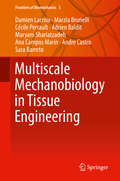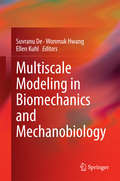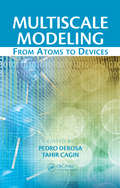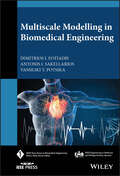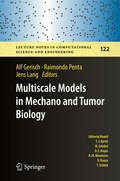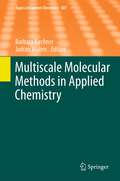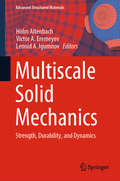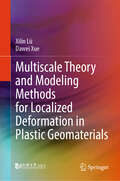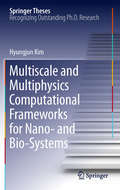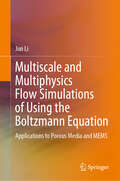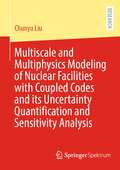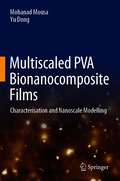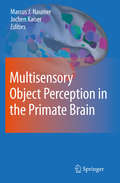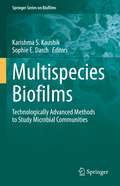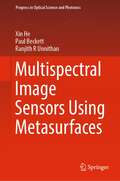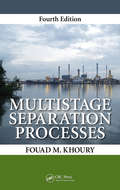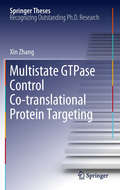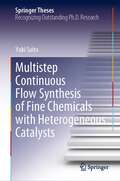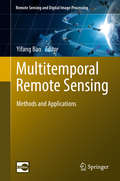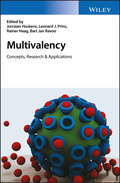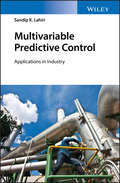- Table View
- List View
Multiscale Mechanobiology in Tissue Engineering (Frontiers of Biomechanics #3)
by Damien Lacroix Marzia Brunelli Cécile Perrault Adrien Baldit Maryam Shariatzadeh Ana Campos Marin Andre Castro Sara BarretoThis book focuses on the mechanobiological principles in tissue engineering with a particular emphasis on the multiscale aspects of the translation of mechanical forces from bioreactors down to the cellular level. The book contributes to a better understanding of the design and use of bioreactors for tissue engineering and the use of mechanical loading to optimize in vitro cell culture conditions. It covers experimental and computational approaches and the combination of both to show the benefits that computational modelling can bring to experimentalists when studying in vitro cell culture within a scaffold. With topics from multidisciplinary fields of the life sciences, medicine, and engineering, this work provides a novel approach to the use of engineering tools for the optimization of biological processes and its application to regenerative medicine. The volume is a valuable resource for researchers and graduate students studying mechanobiology and tissue engineering. For undergraduate students it also provides deep insight into tissue engineering and its use in the design of bioreactors. The book is supplemented with extensive references for all chapters to help the reader to progress through the study of each topic.
Multiscale Modeling in Biomechanics and Mechanobiology
by Suvranu De Wonmuk Hwang Ellen KuhlPresenting a state-of-the-art overview of theoretical and computational models that link characteristic biomechanical phenomena, this book provides guidelines and examples for creating multiscale models in representative systems and organisms. It develops the reader's understanding of and intuition for multiscale phenomena in biomechanics and mechanobiology, and introduces a mathematical framework and computational techniques paramount to creating predictive multiscale models. Biomechanics involves the study of the interactions of physical forces with biological systems at all scales - including molecular, cellular, tissue and organ scales. The emerging field of mechanobiology focuses on the way that cells produce and respond to mechanical forces - bridging the science of mechanics with the disciplines of genetics and molecular biology. Linking disparate spatial and temporal scales using computational techniques is emerging as a key concept in investigating some of the complex problems underlying these disciplines. Providing an invaluable field manual for graduate students and researchers of theoretical and computational modelling in biology, this book is also intended for readers interested in biomedical engineering, applied mechanics and mathematical biology.
Multiscale Modeling: From Atoms to Devices
by PEDRO DEROSA TAHIR CAGINWhile the relevant features and properties of nanosystems necessarily depend on nanoscopic details, their performance resides in the macroscopic world. To rationally develop and accurately predict performance of these systems we must tackle problems where multiple length and time scales are coupled. Rather than forcing a single modeling approach to
Multiscale Modelling in Biomedical Engineering (IEEE Press Series on Biomedical Engineering)
by Dimitrios I. Fotiadis Antonis I. Sakellarios Vassiliki T. PotsikaMultiscale Modelling in Biomedical Engineering Discover how multiscale modeling can enhance patient treatment and outcomes In Multiscale Modelling in Biomedical Engineering, an accomplished team of biomedical professionals delivers a robust treatment of the foundation and background of a general computational methodology for multi-scale modeling. The authors demonstrate how this methodology can be applied to various fields of biomedicine, with a particular focus on orthopedics and cardiovascular medicine. The book begins with a description of the relationship between multiscale modeling and systems biology before moving on to proceed systematically upwards in hierarchical levels from the molecular to the cellular, tissue, and organ level. It then examines multiscale modeling applications in specific functional areas, like mechanotransduction, musculoskeletal, and cardiovascular systems. Multiscale Modelling in Biomedical Engineering offers readers experiments and exercises to illustrate and implement the concepts contained within. Readers will also benefit from the inclusion of: A thorough introduction to systems biology and multi-scale modeling, including a survey of various multi-scale methods and approaches and analyses of their application in systems biology Comprehensive explorations of biomedical imaging and nanoscale modeling at the molecular, cell, tissue, and organ levels Practical discussions of the mechanotransduction perspective, including recent progress and likely future challenges In-depth examinations of risk prediction in patients using big data analytics and data mining Perfect for undergraduate and graduate students of bioengineering, biomechanics, biomedical engineering, and medicine, Multiscale Modelling in Biomedical Engineering will also earn a place in the libraries of industry professional and researchers seeking a one-stop reference to the basic engineering principles of biological systems.
Multiscale Models in Mechano and Tumor Biology: Modeling, Homogenization, And Applications (Lecture Notes in Computational Science and Engineering #122)
by Alf Gerisch Raimondo Penta Jens LangThis book presents and discusses the state of the art and future perspectives in mathematical modeling and homogenization techniques with the focus on addressing key physiological issues in the context of multiphase healthy and malignant biological materials. The highly interdisciplinary content brings together contributions from scientists with complementary areas of expertise, such as pure and applied mathematicians, engineers, and biophysicists. The book also features the lecture notes from a half-day introductory course on asymptotic homogenization. These notes are suitable for undergraduate mathematics or physics students, while the other chapters are aimed at graduate students and researchers.
Multiscale Molecular Methods in Applied Chemistry
by Barbara Kirchner Jadran VrabecFirst-Principles-Based Multiscale, Multiparadigm Molecular Mechanics and Dynamics Methods for Describing Complex Chemical Processes, by A. Jaramillo-Botero, R. Nielsen, R. Abrol, J. Su, T. Pascal, J. Mueller and W. A. Goddard.- Dynamic QM/MM: A Hybrid Approach to Simulating Gas-Liquid Interactions, by S. Yockel and G. C. Schatz.- Multiscale Modelling in Computational Heterogeneous Catalysis, by F. J. Keil.- Real-World Predictions from Ab Initio Molecular Dynamics Simulations, by B. Kirchner, P. J. di Dio and J. Hutter.- Nanoscale Wetting Under Electric Field from Molecular Simulations, by C. D. Daub, D. Bratko and A. Luzar.- Molecular Simulations of Retention in Chromatographic Systems: Use of Biased Monte Carlo Techniques to Access Multiple Time and Length Scales, by J. L. Rafferty, J. I. Siepmann, M. R. Schure.- Thermodynamic Properties for Applications in Chemical Industry via Classical Force Fields, by G. Guevara-Carrion, H. Hasse and J. Vrabec.- Multiscale Approaches and Perspectives to Modeling Aqueous Electrolytes and Polyelectrolytes, by L. Delle Site, C. Holm and N. F. A. van der Vegt.- Coarse-Grained Modeling for Macromolecular Chemistry, by H. A. Karimi-Varzaneh and F. Müller-Plathe.-
Multiscale Solid Mechanics: Strength, Durability, and Dynamics (Advanced Structured Materials #141)
by Holm Altenbach Victor A. Eremeyev Leonid A. IgumnovThis book provides an overview of the current of the state of the art in the multiscale mechanics of solids and structures. It comprehensively discusses new materials, including theoretical and experimental investigations their durability and strength, as well as fractures and damage
Multiscale Theory and Modeling Methods for Localized Deformation in Plastic Geomaterials
by Xilin Lü Dawei XueThe book adopts a multiscale theoretical framework to systematically address localized deformation in plastic geomaterials. It integrates experimental findings with advanced numerical methods, including discrete element simulations and finite element modeling using higher-order continuum theories, providing a comprehensive understanding from micro- to macroscale perspectives. The book will provide insights into the nuances of strain localization that traditional modeling often overlooks, thereby enhancing predictive accuracy and model fidelity. The book is designed for graduate students, researchers, and professionals in geotechnical engineering, materials science, and related fields who have a solid grounding in continuum mechanics and numerical methods. It is also suitable for readers seeking an advanced, research-focused perspective on multiscale modeling.
Multiscale Theory of Composites and Random Media
by Xi Frank XuThis is the first book to introduce Green-function-based multiscale theory and the corresponding finite element method, which are readily applicable to composites and random media. The methodology is considered to be the one that most effectively tackles the uncertainty of stress propagation in complex heterogeneities of random media, and which presents multiscale theory from distinctive scale separation and scale-coupling viewpoints. <P><P>Deliberately taking a multiscale perspective, it covers scale separation and then scale coupling. Both micromechanics and novel scale-coupling mechanics are described in relation to variational principles and bounds, as well as in the emerging topics on percolation and scale-coupling computation. It gives detail on the different bounds encountered, covering classical second and third order, new fourth order, and innovative ellipsoidal variations. <P><P>Green-function-based multiscale theory is addressed to applications in solid mechanics and transport of complex media ranging from micro- and nano-composites, polycrystals, soils, rocks, cementitious materials, to biological materials. It is useful as a graduate textbook in civil and mechanical engineering and as a reference.
Multiscale and Multiphysics Computational Frameworks for Nano- and Bio-Systems
by Hyungjun KimThis volume develops multiscale and multiphysics simulation methods to understand nano- and bio-systems by overcoming the limitations of time- and length-scales. Here the key issue is to extend current computational simulation methods to be useful for providing microscopic understanding of complex experimental systems. This thesis discusses the multiscale simulation approaches in nanoscale metal-insulator-metal junction, molecular memory, ionic transport in zeolite systems, dynamics of biomolecules such as lipids, and model lung system. Based on the cases discussed here, the author suggests various systematic strategies to overcome the limitations in time- and length-scales of the traditional monoscale approaches.
Multiscale and Multiphysics Flow Simulations of Using the Boltzmann Equation: Applications to Porous Media and MEMS
by Jun LiThis book provides a comprehensive introduction to the kinetic theory for describing flow problems from molecular scale, hydrodynamic scale, to Darcy scale. The author presents various numerical algorithms to solve the same Boltzmann-like equation for different applications of different scales, in which the dominant transport mechanisms may differ. This book presents a concise introduction to the Boltzmann equation of the kinetic theory, based on which different simulation methods that were independently developed for solving problems of different fields can be naturally related to each other. Then, the advantages and disadvantages of different methods will be discussed with reference to each other. It mainly covers four advanced simulation methods based on the Boltzmann equation (i.e., direct simulation Monte Carlo method, direct simulation BGK method, discrete velocity method, and lattice Boltzmann method) and their applications with detailed results. In particular, many simulations are included to demonstrate the applications for both conventional and unconventional reservoirs. With the development of high-resolution CT and high-performance computing facilities, the study of digital rock physics is becoming increasingly important for understanding the mechanisms of enhanced oil and gas recovery. The advanced methods presented here have broad applications in petroleum engineering as well as mechanical engineering , making them of interest to researchers, professionals, and graduate students alike. At the same time, instructors can use the codes at the end of the book to help their students implement the advanced technology in solving real industrial problems.
Multiscale and Multiphysics Modeling of Nuclear Facilities with Coupled Codes and its Uncertainty Quantification and Sensitivity Analysis
by Chunyu LiuIn this book, the author provides a deep study into multiscale and multiphysics modeling of nuclear facilities, underscoring the critical role of uncertainty quantification and sensitivity analysis to ensure the confidence in the numerical results and to identify the system characteristics. Through an in-depth study of the liquid metal cooling system from the TALL-3D loop to the SMDFR core, the research highlights the natural circulation instability, strong coupling effects, perturbation tolerance, and system stability. The culmination of the research is the formulation of an optimized uncertainty-based control scheme, demonstrating its versatility beyond the nuclear domain to other energy sectors. This groundbreaking work not only advances the comprehension and utilization of coupling schemes and uncertainty methodologies in nuclear system modeling but also adeptly bridges the theoretical constructs with tangible application, positioning itself as an indispensable resource for design, safety analysis, and advanced numerical modeling in the broader energy sector.
Multiscale and Multiphysics Modelling for Advanced and Sustainable Materials: Euromech Colloquium 642 (Advanced Structured Materials #231)
by Patrizia Trovalusci Tomasz Sadowski Adnan IbrahimbegovicThis book offers the proceedings of Euromech colloquium 642, which wanted to provide a forum to present and debate several advanced computational, experimental, and analytical methods for studying the behaviour of complex materials and structures. The goal was to gather researchers (engineers, physicists, and mathematicians) specialized in multiscale material modelling for simulating the mechanics of solids and the physics of matter with the final aim of bridging the gap between solids and structural mechanics and material science in the modelling of “complex” materials. Both computational and experimental aspects play a central role, and talks have also focused on a broad range of aspects either related to the material modelling or the structural one. Various types of complex materials, made of very different constituents, are used nowadays in engineering practice: particle or fibrous composites; laminates; green composites with natural fillers and industrial or urban recyclable materials; nanomaterials; architecture material; in general complex multiphase materials with a complex internal structure including: porosity, reinforcement in the form of short fibres and particles of various properties, shapes, and sizes, filled in different media. It is widely recognized that important macroscopic properties such as the macroscopic stiffness and strength are governed by multiphysics processes (e.g. damage due to heat transfer or fluid penetration, crack propagation under thermal shock in ceramic/metallic matrix composites, etc.) which occur at one to several scales below the level of observation. A thorough understanding of how these processes influence the reduction of stiffness and strength is a key to the analysis of existing, and the design of improved, complex materials. The colloquium was centred on “Multiscale and Multiphysics Modeling of Complex Materials”, with attention to the constitutive aspects concerning complex materials, so defined for the presence of internal structure at different scales (nano/micro/meso) and nonlinear constitutive behaviour (plasticity, damage, fracture, etc.).
Multiscaled PVA Bionanocomposite Films: Characterisation and Nanoscale Modelling
by Yu Dong Mohanad MousaThis book highlights a novel and holistic approach to multiscaled PVA bionanocomposite films used for electrical sensing, medical and packaging applications. With a combination of material characterization and modeling to understand the effect of nanoparticle size and shape, as well as 3D interphase properties and features such as interphase modulus and nanoscale dimensions, this book substantiates how excellent mechanical and thermal properties of these materials are achieved. Also it addresses the importance of using economical and ecofriendly bionanocomposites as potential green materials to support the goal of environmental sustainability with multifunctional properties.
Multisensory Object Perception in the Primate Brain
by Marcus Johannes Naumer Jochen KaiserTraditionally, a large proportion of perceptual research has assumed a specialization of cortical regions for the processing of stimuli in a single sensory modality. Perception in everyday life, however, usually consists of inputs from multiple sensory channels. Recently the question of how the brain integrates multisensory information has become the focus of a growing number of neuroscientific investigations. This work has identified both multisensory integration regions and crossmodal influences in brain areas traditionally thought to be specific to one sensory modality. Furthermore, several factors have been identified that enhance integration such as spatio-temporal stimulus coincidence and semantic congruency. Multisensory Object Perception in the Primate Brain elucidates the mechanisms of multisensory integration of object-related information with a focus on the visual, auditory, and tactile sensory modalities. Evidence is presented in four sections: methodological considerations, audio-visual processing, visuo-tactile processing, and plasticity, and includes studies in both human and nonhuman primates at different levels of analysis. Studies range from intracranial electrophysiological recordings to non-invasive electro- or magnetoencephalography, functional magnetic resonance imaging, behavioral approaches, and computational modeling.
Multislice-CT of the Abdomen
by Richard Baron Maximilian F. Reiser Carlo Bartolozzi Christoph Johannes ZechThis book provides a lucid summary of modern multislice CT imaging of the abdomen, with a focus on the essential imaging findings. After a concise technical introduction, the most important abdominal diseases are described and illustrated with high-quality images. Sections are devoted to the liver and biliary system, the pancreas and spleen, the kidneys and urogenital system, and the bowel and peritoneal cavity. Throughout, key differential diagnostic features are highlighted. The editorial team is composed of internationally renowned radiologists from Europe and the United States, and all chapters have been written by recognized experts in the topic under consideration. Multislice CT of the Abdomen will serve as an excellent reference for radiologists participating in further professional training and will prove an ideal source of information for all who wish to deepen their personal knowledge of the subject.
Multispecies Biofilms: Technologically Advanced Methods to Study Microbial Communities (Springer Series on Biofilms #12)
by Karishma S. Kaushik Sophie E. DarchIn an age of antibiotic resistant infections, the study of biofilms is increasingly important. Microbes more than often exist in complex multi-species or polymicrobial communities, making infections difficult to detect, diagnose and treat. Given the increased focus on studying biofilms in research and laboratory settings, particularly under conditions that closely mimic the clinical state, it is important to get an overview of the recent methods, model systems and tools being developed and employed in this context.This book offers readers the opportunity to learn more about current methods being used in the investigation of multi-species biofilms, both in vivo and in vitro. For this, the book highlights new technologies built and designed for the study of multiple species within biofilm communities, including those that can be leveraged for the evaluation of antimicrobial treatment approaches. The application of these state-of-the-art techniques to further our understanding of multi-species biofilms will be discussed and the reader will learn how the clinical microenvironment and the development of biofilm communities are considered when developing such tools.With cutting-edge contributions from experts in the respective domains, this book will benefit translational and basic research scientists, as well as clinicians, and is an informative resource for educators and their students.
Multispectral Biometrics
by David Zhang Zhenhua Guo Yazhuo GongDescribing several new biometric technologies, such as high-resolution fingerprint, finger-knuckle-print, multi-spectral backhand, 3D fingerprint, tongueprint, 3D ear, and multi-spectral iris recognition technologies, this book analyzes a number of efficient feature extraction, matching and fusion algorithms and how potential systems have been developed. Focusing on how to develop new biometric technologies based on the requirements of applications, and how to design efficient algorithms to deliver better performance, the work is based on the author's research with experimental results under different challenging conditions described in the text. The book offers a valuable resource for researchers, professionals and postgraduate students working in the fields of computer vision, pattern recognition, biometrics, and security applications, amongst others.
Multispectral Image Sensors Using Metasurfaces (Progress in Optical Science and Photonics #17)
by Xin He Paul Beckett Ranjith R UnnithanThis book presents how metasurfaces are exploited to develop new low-cost single sensor based multispectral cameras. Multispectral cameras extend the concept of conventional colour cameras to capture images with multiple color bands and with narrow spectral passbands. Images from a multispectral camera can extract significant amount of additional information that the human eye or a normal camera fails to capture and thus have important applications in precision agriculture, forestry, medicine, object identifications, and classifications. Conventional multispectral cameras are made up of multiple image sensors each externally fitted with a narrow passband wavelength filters, optics and multiple electronics. The need for multiple sensors for each band results in a number of problems such as being bulky, power hungry and suffering from image co-registration problems which in turn limits their wide usage. The above problems can be eliminated if a multispectral camera is developed using one single image sensor.
Multistage Separation Processes
by Fouad M. KhouryThe latest edition of a perennial bestseller, Multistage Separation Processes, Fourth Edition provides a clear and thorough presentation of the theoretical foundation, and understanding of the development, evaluation, design, and optimization steps of these processes, from both an academic and industrial perspective. The book's emphasis on starting
Multistate GTPase Control Co-translational Protein Targeting
by Xin ZhangProteins act as macromolecular machinery that mediate many diverse biological processes - the molecular mechanisms of this machinery has fascinated biologists for decades. Analysis of the kinetic and thermodynamic features of these mechanisms could reveal unprecedented aspects of how the machinery function and will eventually lead to a novel understanding of various biological processes. This dissertation comprehensively demonstrates how two universally conserved guanosine triphosphatases in the signal recognition particle and its membrane receptor maintain the efficiency and fidelity of the co-translational protein targeting process essential to all cells. A series of quantitative experiments reveal that the highly ordered and coordinated conformational states of the machinery are the key to their regulatory function. This dissertation also offers a mechanistic view of another fascinating system in which multistate protein machinery closely control critical biological processes. Written while completing graduate work at California Institute of Technology.
Multistep Continuous Flow Synthesis of Fine Chemicals with Heterogeneous Catalysts (Springer Theses)
by Yuki SaitoThis book describes the development of two kinds of continuous-flow transformation using heterogeneous catalysts, and explains how they can be applied in the multistep synthesis of active pharmaceutical ingredients. It demonstrates and proves that fine chemicals can be synthesized under continuous-flow conditions using heterogeneous catalysis alone. Importantly, the book also proposes a general concept and strategy for achieving multistep flow synthesis and developing heterogeneous catalysts, and shows that commercially available anion exchange resin can be used as a water-tolerant strong base catalyst for various types of continuous-flow aldol-type reaction. Reviewing the state of the art in heterogeneous catalysis in flow chemistry – a “hot topic” and rapidly developing area of organic synthesis – the book will provide readers with a deeper understanding of fine chemical flow synthesis and its future prospects.
Multitemporal Remote Sensing: Methods and Applications (Remote Sensing and Digital Image Processing #20)
by Yifang BanWritten by world renowned scientists, this book provides an excellent overview of a wide array of methods and techniques for the processing and analysis of multitemporal remotely sensed images. These methods and techniques include change detection, multitemporal data fusion, coarse-resolution time series processing, and interferometric SAR multitemporal processing, among others. A broad range of multitemporal datasets are used in their methodology demonstrations and application examples, including multispectral, hyperspectral, SAR and passive microwave data. This book features a variety of application examples covering both land and aquatic environments. Land applications include urban, agriculture, habitat disturbance, vegetation dynamics, soil moisture, land surface albedo, land surface temperature, glacier and disaster recovery. Aquatic applications include monitoring water quality, water surface areas and water fluctuation in wetland areas, spatial distribution patterns and temporal fluctuation trends of global land surface water, as well as evaluation of water quality in several coastal and marine environments.This book will help scientists, practitioners, students gain a greater understanding of how multitemporal remote sensing could be effectively used to monitor our changing planet at local, regional, and global scales.
Multivalency: Concepts, Research and Applications
by Jurriaan Huskens Leonard J. Prins Rainer Haag Bart Jan RavooConnects fundamental knowledge of multivalent interactions with current practice and state-of-the-art applications Multivalency is a widespread phenomenon, with applications spanning supramolecular chemistry, materials chemistry, pharmaceutical chemistry and biochemistry. This advanced textbook provides students and junior scientists with an excellent introduction to the fundamentals of multivalent interactions, whilst expanding the knowledge of experienced researchers in the field. Multivalency: Concepts, Research & Applications is divided into three parts. Part one provides background knowledge on various aspects of multivalency and cooperativity and presents practical methods for their study. Fundamental aspects such as thermodynamics, kinetics and the principle of effective molarity are described, and characterisation methods, experimental methodologies and data treatment methods are also discussed. Parts two and three provide an overview of current systems in which multivalency plays an important role in chemistry and biology, with a focus on the design rules, underlying chemistry and the fundamental principles of multivalency. The systems covered range from chemical/materials-based ones such as dendrimers and sensors, to biological systems including cell recognition and protein binding. Examples and case studies from biochemistry/bioorganic chemistry as well as synthetic systems feature throughout the book. Introduces students and young scientists to the field of multivalent interactions and assists experienced researchers utilising the methodologies in their work Features examples and case studies from biochemistry/bioorganic chemistry, as well as synthetic systems throughout the book Edited by leading experts in the field with contributions from established scientists Multivalency: Concepts, Research & Applications is recommended for graduate students and junior scientists in supramolecular chemistry and related fields, looking for an introduction to multivalent interactions. It is also highly useful to experienced academics and scientists in industry working on research relating to multivalent and cooperative systems in supramolecular chemistry, organic chemistry, pharmaceutical chemistry, chemical biology, biochemistry, materials science and nanotechnology.
Multivariable Predictive Control: Applications in Industry
by Sandip K. LahiriA guide to all practical aspects of building, implementing, managing, and maintaining MPC applications in industrial plants Multivariable Predictive Control: Applications in Industry provides engineers with a thorough understanding of all practical aspects of multivariate predictive control (MPC) applications, as well as expert guidance on how to derive maximum benefit from those systems. Short on theory and long on step-by-step information, it covers everything plant process engineers and control engineers need to know about building, deploying, and managing MPC applications in their companies. MPC has more than proven itself to be one the most important tools for optimising plant operations on an ongoing basis. Companies, worldwide, across a range of industries are successfully using MPC systems to optimise materials and utility consumption, reduce waste, minimise pollution, and maximise production. Unfortunately, due in part to the lack of practical references, plant engineers are often at a loss as to how to manage and maintain MPC systems once the applications have been installed and the consultants and vendors’ reps have left the plant. Written by a chemical engineer with two decades of experience in operations and technical services at petrochemical companies, this book fills that regrettable gap in the professional literature. Provides a cost-benefit analysis of typical MPC projects and reviews commercially available MPC software packages Details software implementation steps, as well as techniques for successfully evaluating and monitoring software performance once it has been installed Features case studies and real-world examples from industries, worldwide, illustrating the advantages and common pitfalls of MPC systems Describes MPC application failures in an array of companies, exposes the root causes of those failures, and offers proven safeguards and corrective measures for avoiding similar failures Multivariable Predictive Control: Applications in Industry is an indispensable resource for plant process engineers and control engineers working in chemical plants, petrochemical companies, and oil refineries in which MPC systems already are operational, or where MPC implementations are being considering.
